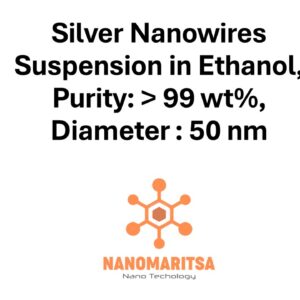Silicon Nanopowder Water Dispersion (Si, 30-50nm, 5wt%) is a colloidal suspension of silicon nanoparticles dispersed in water. Here’s a detailed breakdown of its key features and applications:
- Key Features:
- Silicon (Si): The dispersion contains silicon, a widely used semiconductor material known for its abundance, excellent electronic properties, and thermal stability.
- Nanoparticles: The silicon particles in the dispersion have a size range of 30-50 nanometers (nm). This size range provides a balance between enhanced reactivity and stability.
- Water Dispersion: The nanoparticles are uniformly suspended in water, forming a stable colloidal solution that prevents particle aggregation or settling over time.
- Concentration: The dispersion contains 5 wt% (weight percent), which means 5 grams of silicon nanoparticles per 100 grams of solution.
- Properties:
- Medium Particle Size: The 30-50 nm size range of the silicon nanoparticles provides increased surface area compared to bulk silicon, which enhances their reactivity and usability in various applications while maintaining a relatively stable dispersion.
- Semiconductor Properties: Silicon has excellent semiconductor properties, which makes it essential in the electronics industry for components such as transistors and integrated circuits.
- High Stability: The dispersion is typically stabilized to maintain uniform distribution of nanoparticles and prevent aggregation, ensuring consistent performance.
- Thermal Conductivity: Silicon is known for its good thermal conductivity, making it useful in applications requiring efficient heat management.
- Applications:
- Electronics and Semiconductors: Silicon nanoparticles are used in electronics and semiconductor applications, including the development of high-performance transistors, diodes, and integrated circuits.
- Solar Cells: Silicon is a key material in solar cells. The nanoparticles can enhance the efficiency of solar cells by improving light absorption and electron transport.
- Energy Storage: Silicon nanoparticles are used in the development of next-generation energy storage devices, such as lithium-ion batteries, to enhance energy capacity and cycle life.
- Thermal Management: Due to its thermal conductivity, silicon nanoparticles are used in heat dissipation applications, such as in electronic devices, where efficient cooling is critical.
- Catalysis: Silicon nanoparticles can be used as catalysts or catalyst supports in certain chemical reactions, particularly in the production of fuels or fine chemicals.
- Handling and Safety:
- Toxicity: Silicon nanoparticles are generally considered non-toxic. However, as with all nanoparticles, it is important to handle them with care to avoid inhalation, ingestion, or skin contact. Always follow safety guidelines when working with the dispersion.
- Storage: To preserve the stability of the dispersion, it should be stored in a cool, dark environment, and away from heat sources to prevent nanoparticle aggregation.
- Precautions: Use appropriate personal protective equipment, including gloves, goggles, and lab coats, when handling the dispersion. Work in a well-ventilated area or under a fume hood to minimize exposure to airborne particles.
With a concentration of 5 wt%, this dispersion provides a relatively high concentration of silicon nanoparticles, making it suitable for high-performance applications in electronics, solar energy, and energy storage.
SKU: MN07MPD0218
Category: Metal Dispersions
| Measurement (ml) | 100 ml, 500 ml, 1000 ml |
|---|
Related products
-
Metal Dispersions
Sulphur Nanopowder Water Dispersion (S, 40-50nm, 10wt% )
0 out of 5(0)SKU: MN07MPD0219€130.00 This product has multiple variants. The options may be chosen on the product page -
Metal Dispersions
Silver Ag Nanopowder Water Dispersion (Ag, 15 nm, 10000ppm)
0 out of 5(0)SKU: MN07MPD0205€130.00 This product has multiple variants. The options may be chosen on the product page -
Metal Dispersions
Silver Nanowires Suspension in Ethanol, Purity: > 99 wt%, Diameter : 50 nm
0 out of 5(0)SKU: MN07MPD0207€540.00 This product has multiple variants. The options may be chosen on the product page -
Metal Dispersions
Silver Ag Nanopowder Water Dispersion (Ag, 15 nm, 50000ppm)
0 out of 5(0)SKU: MN07MPD0206€320.00 This product has multiple variants. The options may be chosen on the product page






